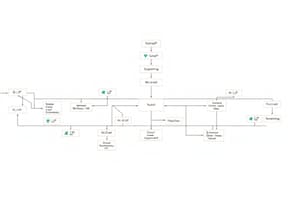Podcast
Questions and Answers
What is the main purpose of a sequence diagram?
What is the main purpose of a sequence diagram?
- To replace communication diagrams in software development
- To model the interactions between objects in multiple use cases
- To illustrate the behavior of a system or help developers design complex systems (correct)
- To represent the timeline of a system's interactions in a circular format
What is the structure of a sequence diagram?
What is the structure of a sequence diagram?
- A circular timeline that represents the sequence of interactions
- A vertical timeline that represents the sequence of interactions (correct)
- A horizontal timeline that represents the sequence of interactions
- A grid-based timeline that represents the sequence of interactions
What do lifeline notations in a sequence diagram represent?
What do lifeline notations in a sequence diagram represent?
- The use cases of the system
- The timeline of the system's interactions
- The different objects or parts that interact with each other in the system (correct)
- The messages exchanged between objects
Why are sequence diagrams preferred by developers and readers?
Why are sequence diagrams preferred by developers and readers?
What is the purpose of the arrows in a sequence diagram?
What is the purpose of the arrows in a sequence diagram?
What does a lifeline with an actor element symbol represent in a sequence diagram?
What does a lifeline with an actor element symbol represent in a sequence diagram?
What is the purpose of an activation bar in a sequence diagram?
What is the purpose of an activation bar in a sequence diagram?
What is the format of a message signature in a sequence diagram?
What is the format of a message signature in a sequence diagram?
What does a lifeline with a control element symbol represent in a sequence diagram?
What does a lifeline with a control element symbol represent in a sequence diagram?
In a sequence diagram, what direction can a message flow?
In a sequence diagram, what direction can a message flow?
Flashcards are hidden until you start studying
Study Notes
Interaction Diagrams
- There are 3 types of Interaction diagrams: Sequence diagrams, Communication diagrams, and Timing diagrams.
- These diagrams illustrate interactions between parts within a system.
Sequence Diagrams
- Sequence diagrams model the interactions between objects in a single use case.
- They illustrate how different parts of a system interact with each other to carry out a function, and the order in which the interactions occur.
- Sequence diagrams are commonly used in software development to illustrate the behavior of a system or to help developers design and understand complex systems.
- They can be used to model both simple and complex interactions between objects.
Sequence Diagram Structure
- A sequence diagram represents a timeline that begins at the top and descends gradually to mark the sequence of interactions.
- Each object has a column, and the messages exchanged between them are represented by arrows.
Lifeline Notation
- A sequence diagram is made up of several lifeline notations that are arranged horizontally across the top of the diagram.
- No two lifeline notations should overlap each other.
- Lifeline notations represent the different objects or parts that interact with each other in the system during the sequence.
Lifeline Elements
- A lifeline notation with an actor element symbol is used when the particular sequence diagram is owned by a use case.
- A lifeline with an entity element represents system data.
- A lifeline with a boundary element indicates a system boundary/ software element in a system.
- A lifeline with a control element indicates a controlling entity or manager.
Activation Bars
- The activation bar is a box placed on the lifeline, indicating that an object is active (or instantiated) during an interaction between two objects.
- The length of the rectangle indicates the duration of the object staying active.
Message Arrows
- An arrow from the Message Caller to the Message Receiver specifies a message in a sequence diagram.
- A message can flow in any direction; from left to right, right to left, or back to the Message Caller itself.
- The message arrow comes with a description, known as a message signature, on it.
- The format for the message signature is: attribute = message_name (arguments): return_type.
Studying That Suits You
Use AI to generate personalized quizzes and flashcards to suit your learning preferences.




